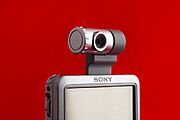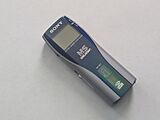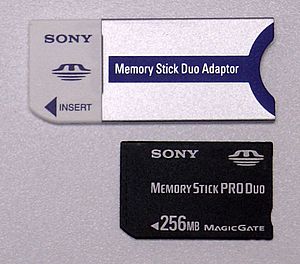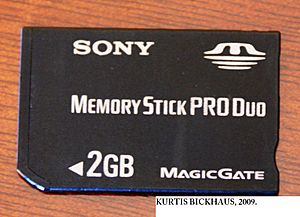Memory Stick facts for kids
 |
|
|---|---|

From top to bottom: Memory Stick PRO, Memory Stick PRO Duo, Memory Stick Micro (M2)
|
|
| Media type | Flash memory card |
| Capacity | 128 MB (Original) 32 GB (PRO series) 2 TB (XC series) |
| Developed by | Sony |
| Extended to | Memory Stick PRO, Memory Stick Duo, Memory Stick PRO Duo, Memory Stick PRO-HG Duo, and Memory Stick Micro |
The Memory Stick is a special type of flash memory card. It was first created by Sony in late 1998. Think of it like a tiny, removable storage device for your digital stuff!
Over time, Sony made different versions of the Memory Stick. These included the Memory Stick PRO, which could hold more data and transfer it faster. There was also the smaller Memory Stick Duo (and the PRO Duo), and the even tinier Memory Stick Micro (called M2). The Memory Stick PRO-HG was a super-fast version, great for high-definition video and photos.
For many years, Sony used Memory Sticks in almost all their products. This included Cyber-shot digital cameras, Handycam camcorders, Sony Ericsson phones, WEGA and Bravia TVs, VAIO computers, music players, and the PlayStation Portable game console. A few other companies also used them.
Around 2010, another type of memory card, the Secure Digital card, became very popular. Sony then started to use SD cards in their devices too. This showed that the Memory Stick was no longer the main memory card. Even so, Sony still lets some newer devices use Memory Sticks with special adapters.
Contents
How Memory Sticks Started
The first Memory Stick came out in October 1998. It could store up to 128 MB of data.
In 1999, Sony let other companies like Fujitsu, Aiwa, and Sharp use their Memory Stick technology. This helped the Memory Stick become more popular. Some early examples of other companies using Memory Sticks included Sharp's MP3 players and Epson's printers.
At first, people weren't sure about the Memory Stick. But after more companies started using it, its popularity grew. By 2001, Memory Stick had a good share of the memory card market. However, the SD card, made by Toshiba, Panasonic, and SanDisk, quickly became the most popular. Many people thought Memory Sticks were too expensive compared to other cards.
By 2010, Sony began putting slots for both SD cards and Memory Sticks in their products. This included their digital cameras and camcorders. Many people saw this as the end of the "format war" between Memory Stick and SD cards. Sony did not completely stop making Memory Sticks at that time. They even worked on a special Memory Stick PRO-Duo that could transfer files using Wi-Fi.
However, in 2019, Sony released a new camera, the α7R IV, that only used SD cards. This was a big step away from Memory Stick.
What Memory Sticks Were Used For
Memory Sticks were mainly used to store files in portable devices. You could easily take the card out and put it into a computer. For example, Sony digital cameras used Memory Sticks to save pictures. You could then copy these pictures to your computer using a Memory Stick reader.
Sony often built Memory Stick readers into their own electronics. This included digital cameras, music players, PDAs, cell phones, VAIO laptops, WEGA and Bravia TVs, and the PlayStation Portable game console.
-
Sony PEGA-MSC1 digital camera connected to the Clié PEG-SJ20 via its Memory Stick slot
-
Sony MS Walkman (NW-MS7) digital audio player with inserted Memory Stick
A special Memory Stick could even be put into Sony's AIBO robot pet. This allowed the robot to use special software. These cards had a copy protection system and let users write programs for the robot.
Types and Sizes of Memory Sticks
Memory Sticks came in many different types and sizes.
Original Memory Stick
The first Memory Stick came out in July 1998. It was about the size of a stick of chewing gum. It could store from 4 MB to 128 MB of data. Some versions had "MagicGate" support, which was a way to protect digital content. MagicGate cards were white, while standard ones were purple. The original Memory Stick is no longer made.
Memory Stick Select

To offer more storage, Sony released the Memory Stick Select in 2003. This card had two separate 128 MB sections. You could switch between them using a small switch on the card. It wasn't very popular, but it gave older devices more storage. It was the same size as the original Memory Stick.
Memory Stick PRO
The Memory Stick PRO was also introduced in 2003 by Sony and SanDisk. This was a better solution for storage. Most devices that used the original Memory Sticks could also use PRO sticks because they were the same size. Some older readers could even be updated to work with PRO sticks.
Memory Stick PROs had faster transfer speeds. They could theoretically hold up to 32 GB of data. "High Speed" Memory Stick PROs were also made for even faster transfers. These faster cards still worked with older devices, just at a slower speed. High-capacity Memory Sticks were often more expensive than other types of memory cards like SD cards.
Memory Stick Duo
Introduced in July 2002, the Memory Stick Duo was much smaller. Sony needed a tiny memory card for small digital cameras, cell phones, and the PlayStation Portable. It was a bit smaller than the popular Secure Digital (SD) card. Memory Stick Duos had the same features as the larger Memory Stick, including high-speed options and MagicGate support. The Memory Stick PRO Duo later replaced it because the Duo could only hold up to 128 MB.
You could use a simple adapter to make a Memory Stick Duo fit into devices designed for the original, larger Memory Stick.
Memory Stick PRO Duo
The Memory Stick PRO Duo (MSPD) quickly took over from the Memory Stick Duo. This was because the Duo had a small storage limit (128 MB) and was slow. PRO Duos came with all the same options as the larger Memory Stick PRO, like high-speed and MagicGate.
Sony released different sizes of Memory Stick PRO Duo, including 16 GB and 32 GB versions. Sony and SanDisk also worked on an even bigger version called "Memory Stick XC."
You can even find adapters that let you use microSD cards in devices that only support Memory Stick PRO Duo cards.
Memory Stick PRO-HG Duo
In 2006, Sony and SanDisk announced the Memory Stick PRO-HG Duo. This version was much faster than the PRO format. It could transfer data up to three times faster, reaching speeds of 60 MB per second. This made it great for recording high-quality videos.
Memory Stick Micro (M2)
Sony and SanDisk released the Memory Stick Micro (M2) in 2006. It was tiny, measuring only 15 × 12.5 × 1.2 mm. That's about one-quarter the size of the Duo! It came in sizes from 64 MB up to 16 GB. It could theoretically hold up to 32 GB and transfer data at 160 Mbit/s. Even larger "XC" versions were planned, with a theoretical limit of 2 TB.
The M2 came with an adapter so it could fit into devices made for Memory Stick PRO. However, some older devices might not work with the M2/Adapter if the M2 card was too large for them. For example, some older Sony CLIÉ PDAs couldn't use cards bigger than 2 GB.
In 2009, Sony announced that their Sony Ericsson phones would stop using M2 cards and switch to microSD cards instead. However, the Sony DSC-RX0 Mark II camera, released later, did use M2 slots.
Memory Stick XC
In 2009, SanDisk and Sony announced the Memory Stick XC format. This format had a huge theoretical capacity of 2 TB, which is 64 times more than the 32 GB limit of the PRO Duo. XC cards had the same shape as PRO series cards and supported MagicGate. They also used a newer file system called exFAT, which is better for very large storage sizes. They could transfer data at 60 MB per second. However, no Memory Stick XC cards were ever released to the market. This was likely because SD cards, especially SDXC cards, became much more popular.
Memory Stick PRO-HG Duo HX
Sony released the Memory Stick PRO-HG Duo HX in 2011. This was considered the fastest Memory Stick ever made by Sony at the time. It was 20 × 31 × 1.6 mm in size and came in 8 GB, 16 GB, or 32 GB versions. It could transfer data at a maximum speed of 50 MB per second.
Mark 2 Certification
Around 2008, Memory Stick PRO Duo cards with a "Mark 2" certification became available. This "Mark 2" label meant the Memory Stick was good for recording AVCHD videos or for other devices that needed faster memory cards. It showed that the card could write data at a certain minimum speed.
See also
 In Spanish: Memory Stick para niños
In Spanish: Memory Stick para niños
- Comparison of memory cards
- Format war
- MultiMediaCard
- SmartMedia Card
- xD Picture Card
- USB flash drive










